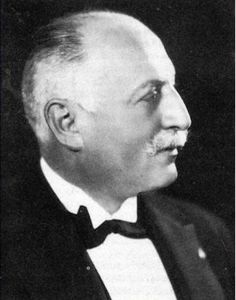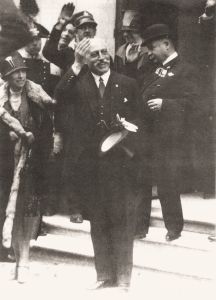The Podestà
 Pietro Agosti was born in Bordighera on 1st April 1873.
Pietro Agosti was born in Bordighera on 1st April 1873.
His father Giuseppe, who was born in the province of Alessandria, was transferred to Bordighera where he met his wife, Caterina Amoretti, Pietro's mother.
In the following years, his father was transferred to Ospedaletti following his promotion to stationmaster, and so Pietro moved there with his family. Pietro Agosti was appointed podestà (mayor) of the city and was officially installed on 26th May 1927, an activity that absorbed him very intensely, so much so that he could hardly devote himself to his planning activity.
Pietro Agosti was appointed podestà (mayor) of the city and was officially installed on 26th May 1927, an activity that absorbed him very intensely, so much so that he could hardly devote himself to his planning activity.
As Podestà, he issued an order imposing a strict supervision of price control which, due to some incorrect traders, had suffered a considerable upsurge. He also took action on the rules on rents, preventing the owners from imposing free rents, but always subject to precise rules decided by the legislator.
Among the many works of Agosti, the reorganization of the police force, which replaced the Urban Police Guards, should also be followed; the policemen on duty wore a red and white striped bracelet.
In order to help the tourist vocation of the city, the Italian government proposed to define the Riviera di Sanremo as "La costa fiorita", but the inspiration of the podestà contrasted with the much more fortunate formula of "Riviera di Ponente".. With a long work of weaving, which led Agosti to request the intervention of Mussolini, by Royal Decree of 22 December 1927 the Casino of Sanremo was established where gambling could be legally practised.
The Casinò di Sanremo officially opened its doors on 12 January 1905 with a concert by the Symphony Orchestra and an inaugural gala evening.
During the Agosti administration, the covering of the San Romolo stream was completed and the Sanremo Golf Course, the Equestrian Course, the Multisports Course (formerly the Stadio del Littorio) and the Pigeon Shooting Stand were put into construction. In addition to the classic Carnival event, also in Spring, there was the Flora goddess event which included a course of flower floats, still very famous today.
Also in those years Pietro Agosti succeeded in having the Municipality buy the Villa Ormond, to which he had a new pavilion added, and the relative gardens to be used as a public park, for which he personally designed the fountain. He was also responsible for the design of the Sanremo - San Romolo - Monte Bignone cable car (built and inaugurated after his death in 1936), as well as the project for the new Hospital.
The rumours that raged at the time about the corruption and homosexuality of Pietro Agosti, skilfully spread by old exponents of Giolittian Italy, including Senator Domenico Nuvoloni, pushed the engineer to go to Rome to confer with the Duce, counting on his intervention that could silence such rumours: however, after three days of waiting, Mussolini let him know that he did not want to receive him.
He also went to the Undersecretary of the Interior, Leandro Arpinati, who could offer nothing but understanding and vague promises.
Pietro Agosti was unable to bear the beating he suffered, which led him to commit suicide the following day, on 29th April 1930 inside the catacombs of St. Callisto, with a gunshot to the temple: next to his body was found a letter, addressed to his brother, in which he explained the reasons for his gesture (see below).
In his last instructions he left a mandate so that his coffin would not be displayed in the Town Hall, but in the first class waiting room of the railway station. This request was probably the answer to some malicious phrase or consideration addressed to him in those days, or he simply wanted to highlight the fact that he had to wait in vain to confer with Mussolini.
In the hall a squadron leader named Ivan Bianchi, escorted Senator Nuvoloni out of the crowd, threw him out of the room. All the accusations made against the podestà later turned out to be completely unfounded.
The funeral honours took place both in Rome and Sanremo and were majestic. All the civil and religious hierarchies of the city took part in them while the band of the 42nd Infantry Regiment played the funeral marches. During the funeral procession, which took place in the main streets of the city, at the passage of the coffin the shops lowered the shutters while the SITAR planes threw flowers.
Pietro Agosti rests today in the Ospedaletti cemetery.
The podestà Pietro Agosti was succeeded by Dr. Manlio Pozzi, former secretary of the Municipality of Milan, who will remain in office for only one year. During his mandate he inaugurated the Pro Infantia, already designed by Agosti, and the ossuary of the War Fallen at the Monumental Cemetery of the Foce.
In June 1932 Manlio Pozzi resigned from office, then the new commissioner Michele De Masellis took office and led the town administration until the appointment of the new Podesta Giovanni Guidi on 7 October 1933. In this brief period he inaugurated the Golf Course and the House of the Mutilated, designed by engineer Parodi. A contract was stipulated with the Compagnia Italiana delle Funivie (Italian Cableway Company) to build and operate the Sanremo-Monte Bignone cableway.
A street in the city of Sanremo was named after Pietro Agosti by the Council resolution of 27 February 1962.
Text of the letter sent to his brother:
"Rome, 29 April 1930 VIII.
Dearest brother Roberto,
As courteous as yesterday's welcome by S.E. Arpinati is, thinking back on it leaves me with the doubt that the disposition already taken towards me is rather delayed or cancelled. Therefore, not being able to remain under this nightmare and on the other hand to return to San Remo with the fear of having to submit to an undeserved humiliation after all that I have done for my City, I decide to implement what I had already arranged days are, that is, to seek peace and rest in eternal quiet.
I therefore wish you to carry out what has been established in my last will and testament.
I forgive those who have wronged me and who are the sure cause of my determination. God forgive me who die hoping for His mercy and goodness and for the protection of the Holy Virgin. I greet and thank all my good friends and also recommend myself to them for a prayer.
Your affectionate brother Pietro".
(Text information freely taken from Wikipedia)




